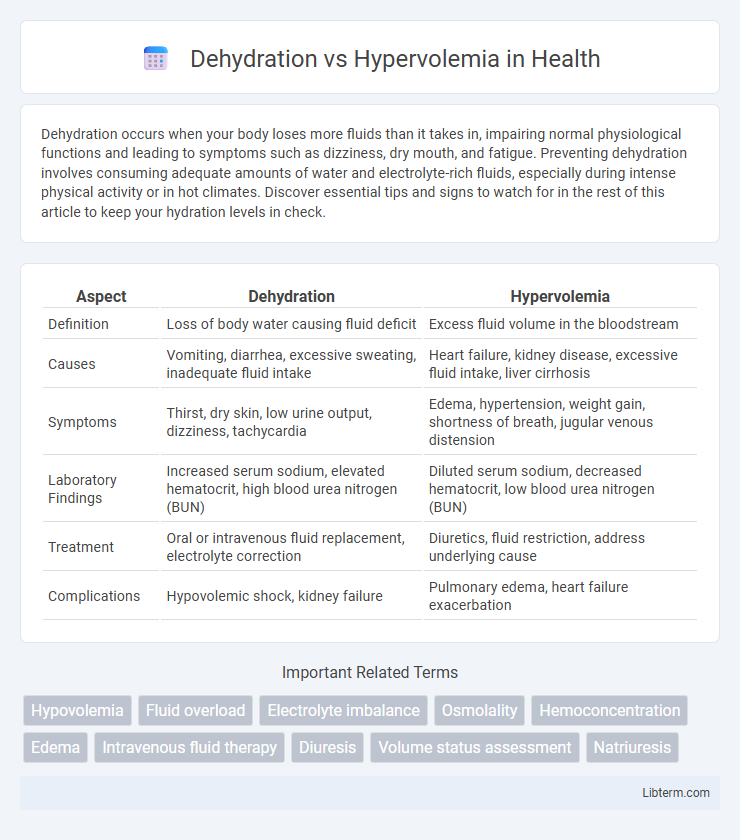Dehydration occurs when your body loses more fluids than it takes in, impairing normal physiological functions and leading to symptoms such as dizziness, dry mouth, and fatigue. Preventing dehydration involves consuming adequate amounts of water and electrolyte-rich fluids, especially during intense physical activity or in hot climates. Discover essential tips and signs to watch for in the rest of this article to keep your hydration levels in check.
Table of Comparison
| Aspect | Dehydration | Hypervolemia |
|---|---|---|
| Definition | Loss of body water causing fluid deficit | Excess fluid volume in the bloodstream |
| Causes | Vomiting, diarrhea, excessive sweating, inadequate fluid intake | Heart failure, kidney disease, excessive fluid intake, liver cirrhosis |
| Symptoms | Thirst, dry skin, low urine output, dizziness, tachycardia | Edema, hypertension, weight gain, shortness of breath, jugular venous distension |
| Laboratory Findings | Increased serum sodium, elevated hematocrit, high blood urea nitrogen (BUN) | Diluted serum sodium, decreased hematocrit, low blood urea nitrogen (BUN) |
| Treatment | Oral or intravenous fluid replacement, electrolyte correction | Diuretics, fluid restriction, address underlying cause |
| Complications | Hypovolemic shock, kidney failure | Pulmonary edema, heart failure exacerbation |
Introduction to Fluid Imbalances
Fluid imbalances occur when the body's fluid levels deviate from normal, manifesting as either dehydration or hypervolemia. Dehydration results from excessive fluid loss exceeding intake, leading to reduced blood volume and cellular dehydration. Hypervolemia involves an abnormal increase in body fluid, causing blood volume expansion and potential edema due to fluid retention.
Understanding Dehydration
Dehydration occurs when the body loses more fluids than it takes in, leading to a deficit in total body water and electrolytes, which impairs cellular function and can cause symptoms like dry skin, dizziness, and confusion. This condition contrasts with hypervolemia, where there is an excessive accumulation of fluid in the bloodstream, often related to kidney or heart conditions. Proper understanding of dehydration involves recognizing its causes such as excessive sweating, diarrhea, or insufficient fluid intake, and monitoring key indicators like urine concentration and blood electrolyte levels to prevent severe complications.
What is Hypervolemia?
Hypervolemia is a medical condition characterized by an excessive volume of fluid in the bloodstream, leading to increased blood pressure and potential strain on the heart. It contrasts with dehydration, where there is a deficit of body fluids causing low blood volume and impaired cellular function. Common causes of hypervolemia include kidney failure, heart failure, and excessive sodium intake.
Causes of Dehydration
Dehydration primarily results from excessive fluid loss due to factors such as prolonged vomiting, diarrhea, sweating, and inadequate fluid intake. Certain medical conditions like diabetes insipidus and diuretic use also contribute to dehydration by increasing urine output. In contrast, hypervolemia is caused by fluid retention associated with heart failure, kidney disease, or excessive intravenous fluid administration.
Causes of Hypervolemia
Hypervolemia, also known as fluid overload, is primarily caused by excessive sodium retention due to conditions such as congestive heart failure, renal failure, and liver cirrhosis. Intravenous fluid administration and certain medications like corticosteroids and nonsteroidal anti-inflammatory drugs (NSAIDs) can also contribute to increased blood volume. Unlike dehydration, which results from fluid loss, hypervolemia involves an abnormal increase in extracellular fluid volume, leading to symptoms like edema and hypertension.
Signs and Symptoms: Dehydration vs Hypervolemia
Dehydration presents with signs such as dry mucous membranes, decreased skin turgor, hypotension, tachycardia, and concentrated urine, indicating fluid loss and electrolyte imbalance. Hypervolemia manifests through symptoms like peripheral edema, elevated blood pressure, jugular venous distension, pulmonary crackles, and weight gain, reflecting fluid overload and compromised cardiac function. Recognizing these contrasting clinical features aids in accurate diagnosis and effective management of fluid status disorders.
Risk Factors and Populations at Risk
Dehydration risk factors include excessive fluid loss from vomiting, diarrhea, sweating, and inadequate fluid intake, with elderly individuals, infants, and those with chronic illnesses being most vulnerable. Hypervolemia, caused by factors such as heart failure, kidney disease, liver cirrhosis, and excessive intravenous fluid administration, predominantly affects patients with impaired fluid regulation and the elderly population. Both conditions require careful monitoring in hospitalized and chronically ill patients to prevent severe complications.
Diagnostic Approaches
Diagnostic approaches for dehydration primarily involve assessing serum electrolytes, blood urea nitrogen (BUN), creatinine levels, and urine osmolality to detect volume depletion and electrolyte imbalances. In contrast, hypervolemia diagnosis relies on clinical evaluation of edema, jugular venous distension, chest X-rays for pulmonary congestion, and laboratory tests showing dilutional hyponatremia or decreased hematocrit. Both conditions may require fluid balance monitoring and hemodynamic measurements for accurate assessment and management.
Treatment and Management Strategies
Dehydration treatment centers on fluid replacement using oral rehydration solutions or intravenous fluids containing electrolytes to restore volume and balance. Hypervolemia management involves diuretics to remove excess fluid, alongside sodium restriction to prevent further fluid retention. Monitoring vital signs and electrolyte levels ensures effective adjustment of therapy and prevention of complications in both conditions.
Prevention Tips for Fluid Imbalances
Maintaining optimal hydration levels requires monitoring fluid intake and recognizing early signs of dehydration, such as dry mouth and dizziness, while avoiding excessive salt consumption that can contribute to hypervolemia. Implementing a balanced diet rich in electrolytes, drinking adequate water throughout the day, and adjusting fluid intake based on activity level and environmental conditions significantly prevent fluid imbalances. Regular medical check-ups to assess kidney function and electrolyte levels also help in managing risks associated with both dehydration and hypervolemia.
Dehydration Infographic

 libterm.com
libterm.com